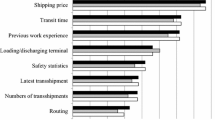Abstract
Maritime trade between East Asia and Northwest Europe using the Northern Sea Route (NSR) has been recently increasing, because ship operators may take advantage of the shorter sailing distance of NSR whose navigable season has become longer because of retreating Arctic sea ice. As Arctic sea ice continues to retreat because of global warming, the NSR is now approximately 40 per cent shorter than the Suez Canal Route (SCR) for such trade. In 2013, shipping on the NSR marked a record 10 year-high volume of 1.36 million tons with 71 voyages. Accordingly, comparative analyses of estimated shipping cost via the NSR and the alternative conventional routes, especially the SCR, have been carried out. Furthermore, NSR/SCR-combined shipping, that is, when a vessel transits the NSR during the warmer months and the SCR in the colder months, has already been proposed as a realistic scenario for Arctic shipping in the previous studies. Since assumptions used in the cost estimations vary among the studies, as discussed by Lasserre, there remain some difficulties when comparing estimated shipping costs. This study aims at establishing a common platform of a wide range of cost estimation assumptions, through clarifying and analysing the cost components contained in the current literature. In addition, interviews with NSR shipping professionals were conducted concerning the NSR fee on an unofficial basis, since typically such fees are determined based on negotiations between ice breaker escort service provider and shipping company. An empirical analysis revealed that NSR/SCR-combined shipping of container cargo between East Asia and Northwest Europe can be commercially feasible.




Similar content being viewed by others
References
Arpiainen, M. and Killi, R. (2006) Arctic Shuttle Container Link from Alaska US and Europe, Report K-63. Helsinki, Finland: Aker Arctic Technology.
Falck, H. (2012) Shipping in Arctic waters – The Northern Sea Route: Mariehamn, Finland, http://www.sjofart.ax/files/henrik_falck_shipping_in_arctic_waters.pdf, accessed 2 April 2014.
Furuichi, M. and Otsuka, N. (2012) Effects of the Arctic Sea Routes (NSR and NWP) Navigability on Port Industry, 21 May, Jerusalem, Israel, Presentation at Port Planning and Development Committee (PPDC), International Association of Ports and Harbors (IAPH).
Hino, M. (2011) Progress of Maritime Shipping Industry and Current Situation: Financial Department of Ehime Bank (in Japanese).
IMO (2009) Second IMO GHG Study 2009 London: IMO.
Isakov, N.A., Yakovlev, A.N., Nikulin, A.E., Serebryansky, G.Y. and Patrakova, T.A. (1999) The NSR Simulation Study Package 3: Potential Cargo Flow Analysis and Economic Evaluation for the Simulation Study (Russian Part), INSROP Working Paper no. 139, St. Petersburg.
Japan Ship-owners Association (2012) Shipping fact 2012 (in Japanese), http://www.jsanet.or.jp/data/pdf/data1_2012b.pdf, accessed 21 December.
Lasserre, F. (2014) Case studies of shipping along Arctic routes. Analysis and profitability perspectives for the container sector. Transportation Research Part A 66: 144–161.
Liu, M. and Kronbak, J. (2010) The potential economic viability of using the Northern Sea Route (NSR) as an alternative route between Asia and Europe. Journal of Transport Geography 18 (3): 434–444.
Maritime Press Japan (2012a) Transactions of newly built merchant fleet in 2012 (1), (in Japanese), 11 December.
Maritime Press Japan (2012b) Transactions of newly built merchant fleet in 2012 (2), (in Japanese), 11 December.
MOL (2012) List of export charges for European line service, http://www.moljapan.co.jp/service/ex_charge/eur.shtml, accessed 21 December.
Omre, A. (2012) An economic transport system of the next generation integrating the northern and southern passage, Master Thesis, Norwegian University of Science and Technology, Trondheim, Norway.
Panama Canal Authority (2012) Panama Canal Fees (as of December, 2012), http://www.pancanal.com/eng/maritime/tolls.html, accessed 21 December.
Russian Federal Law (2012) On Amendments to Certain Legislative Acts of the Russian Federation Concerning State Regulation of Merchant Shipping on the Water Area of the Northern Sea Route, Article 3 Section 5, 28 July, http://www.nsra.ru/en/zakon_o_smp/, accessed March 2014.
Russian Ministry of Justice (2014) Federal Service for Tariffs, Order of 4 March 2014, N 45-t/1, About the Approval of Tariffs for the Ice breaker Escorting of Ships rendered by FSUE ‘ATOMFLOT’ in the Water Area of the Northern Sea Route, http://www.nsra.ru/en/tarrifs_for_icebreaker_escort_atomflot/, accessed March 2014.
Schoyen, H. and Brathen, S. (2011) The Northern Sea Route versus the Suez Canal: Cases from bulk shipping. Journal of Transport Geography 19 (4): 977–983.
Ship & Ocean Foundation (2000) The Northern Sea Route-The Shortest Sea Route Linking East Asia and Europe Tokyo, Japan: Ship & Ocean Foundation.
Suez Canal Authority (2012) Suez Canal Fees (as of December, 2012), http://www.suezcanal.gov.eg/TollCirculars.aspx, accessed 21 December.
UNCTAD (2011) Review of Maritime Transport 2011 Geneva, Switzerland: UNCTAD.
Verny, J. and Grigentin, C. (2009) Container shipping on the Northern Sea Route. International Journal of Production Economics 122 (1): 107–117.
Acknowledgements
This study is largely based on ‘Effects of the Arctic Sea Routes (NSR and NWP) Navigability on Port Industry’ (Project period: 2011–2013), funded by International Association of Ports and Harbors (IAPH). Our special thanks first go to IAPH and all the members of the Port Planning and Development Committee (PPDC) of IAPH. Furthermore, the authors present special thanks to Mr Mitsuhiko Okada, the president of Overseas Coastal Development Institute (OCDI) of Japan for his insight comments.
Author information
Authors and Affiliations
Additional information
Winner of the Palgrave Macmillan ‘Best Conference Paper’ prize at the 2013 Annual Conference (Marseille-France) of the International Association of Maritime Economists (IAME).
Appendix
Rights and permissions
About this article
Cite this article
Furuichi, M., Otsuka, N. Proposing a common platform of shipping cost analysis of the Northern Sea Route and the Suez Canal Route. Marit Econ Logist 17, 9–31 (2015). https://doi.org/10.1057/mel.2014.29
Published:
Issue Date:
DOI: https://doi.org/10.1057/mel.2014.29




